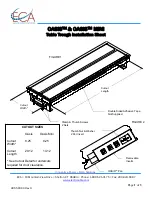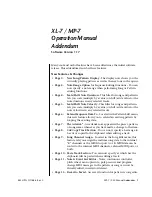
3
MODULE DESCRIPTION
Inmarsat B
3.1.4
DOWN CONVERTER
The purpose of the DOWN converter is to convert an L-band signal to a fixed intermediate frequency of
21.4 MHz. A block diagram is shown in fig. 3.4.
20 kHz
10 kHz
100 kHz
Filter Module
Shift
Register
21.4 MHz
Data
Clock
Strobe
Lo-1
Lo-2
35525
Fig. 3.4
Down conversion takes place in two steps. The L-band signal is mixed to a first intermediate frequency
of 179.32 to 179.6325 MHz. The first IF signal is then mixed to 21.4 MHz. The reason why the first IF is
not fixed is that the frequency of the L-band synthesizer steps in 315 kHz. This is done to lower the close
in phase noise.
From the output of the LNA, the received signal is fed directly to RF input of the first mixer. The mixer is
a passive doubled balanced diode mixer with good large-signal properties. The local oscillator frequency
ranges from 1345.68 to 1365.525 MHz. The signal level from the synthesizer module is 0 dBm ± 3 dB and
is amplified in a MMIC to the required LO drive level of 10 dBm. To avoid power level variation of the local
oscillator input of the mixer, the compression point of the amplifier is approximately 10 dBm. Before
amplification takes place, the signal is filtered. The purpose of this filter is to attenuate spurious
frequencies which may add to the synthesizer module oscillator signal.
The first intermediate frequency consists of two double tuned band-pass filters separated by a dual gate
MOS-FET amplifier. The total power gain including filter losses is approximately 8 dB. The power gain
is temperature compensated by means of an NTC resistor in the bias network of the MOS-FET transistor.
The final down conversion to second IF at 21.4 MHz takes place in the second. This mixer has the same
properties as the first one. The second local oscillator amplifier amplifies the synthesizer signal from
-20 dBm to the required level of 10 dBm. The amplifier is built up as a two stage tuned transistor amplifier
with a 3 dB attenuator separating the transistors. The selectivity is formed by the tuned impedance
matching networks. This amplifier also has a compression point of approximately 10 dBm.
Due to the different types of services (voice, high speed data, telex etc.) different receiver bandwidths are
required. In the DOWN converter it is possible to select between three different crystal filters, i.e. 10, 20
and 100 kHz. Those filters are located on another PCB together with buffer stages and filter selection
circuits. The filter selection is made by means of switch diodes which are controlled by a TTL shift register.
Three control signals (data, clock and strobe) to set up the shift register are supplied from the TSP board.
The filter module buffer stages have two purposes, to amplify the signal and to serve as interconnection
between the filter module and the main board.
Finally the signal is amplified in a two stage dual gate MOS-FET amplifier, and a common collector stage
takes care of the impedance matching to a 50 ohm load.
All internal supply voltages (+15, -12 and 5V) are made by means of integrated voltage regulators.
PAGE 3-3
9901
Summary of Contents for Inmarsat B
Page 1: ...SAILOR Inmarsat B Workshop Manual W4400GB0 ...
Page 2: ...Inmarsat B Workshop Manual 9905 ...
Page 7: ...CONTENTS 1 INTRODUCTION 1 1 1 1 SYSTEM COMPONENTS 1 2 1 2 TECHNICAL DATA 1 2 9849 Inmarsat B ...
Page 46: ...4 ACCESSORIES Inmarsat B PAGE 4 3 Inmarsat B 9849 Diagram Veritas connection box ...
Page 124: ...CONTENTS 8 PERFORMANCE CHECK AFTER REPAIR 8 1 8 1 START UP SEQUENCE 8 1 9936 Inmarsat B ...
Page 127: ...CONTENTS 9 SERVICE 9 1 9 1 CHECK OF OCXO 9 1 9936 Inmarsat B ...
Page 129: ...CONTENTS 10 PARTS LISTS 10 1 9901 Inmarsat B ...
Page 133: ...CONTENTS 11 ABBREVIATIONS 11 1 Inmarsat B 9849 ...
















































